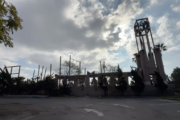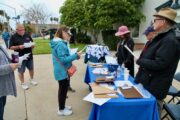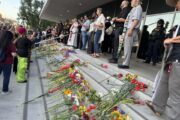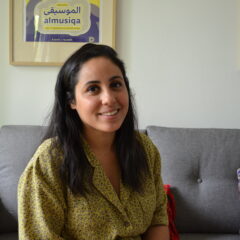Brie Loskota shared the following remarks as the keynote address at Pillars Fund 2016 Convening in Chicago.
I am Brie Loskota. I direct the Center for Religion and Civic Culture at the University of Southern California. We are an interdisciplinary research center. We have a documentation and evaluation practice, as well as a capacity building arm, and a strategy and planning division as well. As part of our work, we run a program founded ten years ago called the American Muslim Civic Leadership Institute. I have had the privilege of working with my co-founder Nadia Roumani and others like Edina Lekovic and Sumaya Abubaker on that initiative.
Our work explores how religions change and how they make change in the world. We are a secular entity that explores all religions, and explores the ranges of what religions do—from the very good and transformational to the incredibly destructive.
We started in the wake of the civil unrest in LA exploring the roles religious groups were playing to reweave the frayed social and civic fabric of our city after police violence gave way to community violence in protest.
Religious groups and religious leaders exchanged pulpits between South LA Black Churches and Valley synagogues; new collaborations were born that gave way hundreds of millions of dollars in economic development spurred by faith community development corporations. It was in this moment that the founders of CRCC realized that religions are often most powerfully productive in times of social upheaval. It is in those moments that people are searching for ways to understand who they are, ways to make sense of the world as it unfolds in all its uncertainty, and ways to connect to something larger than themselves.
The story of how religious actors and organizations exploit times of strife or even help to create them for their own pernicious ends is well known. The ways that religious longings for a more hopeful future in the afterlife serve as a refuge for not addressing the problems of today is also well know. A less fashionable story is the ways in which religions provide motivation and activation for social change not only in history but in our current moments of social upheaval and uncertainty.
Religions and Social Change
Religions have always played roles in shaping people’s views of what the world ought to look like, creating moral norms and values that should be upheld.
But beyond beliefs, religions create locations for people to build social capital, to engage with each other, to learn the work of citizenship. There are few institutions as ubiquitous as religious ones in the US, and very few as socially embedded.
Much is made of the power of the garage to be the site of innovation in the tech industry—guys huddled in their buddy’s garage or their mom’s garage soldering parts, assembling circuit boards, and iterating products until they build the Microsofts and Apples of the world. Obviously there is only a kernel of truth to that, but the image of the garage as the location of gathering for creative entrepreneurial scheming is an evocative one.
Think of congregational basements and social halls as the incubators of social innovation. Meals on Wheels in Los Angeles was founded out of the planning of a parish basement. Congregational members telling stories of personal pain turn into collective stories of society’s fraying social contract. Skilled organizers turn those stories into calls to action that move from the social halls up to the pulpits during Friday, Saturday and Sunday religious services.
And now those older forms of work are being reimagined in the 21st century. The Sikh tradition of langar—serving free meals to the poor—has been turned into a social enterprise in LA where the langar is on a food truck, the free meals are burritos not Punjabi food, and the people serving them come from all walks of life. The langar is underwritten not by donations but by the food truck selling burritos in a buy-one, give-one model, a la Toms Shoes.
Organizing in congregations has given way to organizing online, building organizing capacity through interfaith programs like the community organizing residency of Bend the Arc, which brought Muslim, Christian, Jewish and people of other spiritual backgrounds to learn and create a new organizing traditions that previously were modeled on Judeo-Christian norms.
And Muslim communities are creatively meeting the enormous challenges of today, drawing on the resources of their tradition, their professional skills, and their media savvy.
NewGround, a Jewish and Muslim organization is LA created a short video documentary of Muslims and Jews praying daily prayers side by side in LA, beginning re-dawn on the beach ending with evening on the plaza at City Hall. The video has been seen by hundreds of thousands. A new video that they just posted online yesterday shows Muslim and Jewish youth combatting islamophibia on a busy shopping street in Santa Monica. It has been seen by more than 20,000 people in less than 24 hours.
Other outlets like Huffington Post and Al Jazeera have created informative, funny, and sometimes really moving videos, including a great one about fasting produced by Sharaf Moqjood starring Linda Sarsour that has been seen by millions.
And podcasts like Serial and Undisclosed have highlighted the brokenness of our justice system and made names like Adnan Syed and Rabia Chaudry dinnertime conversational fodder for millions—many of whom have never met a Muslim in person.
After the tragedies of Black Churches being burned and the San Bernardino attack, Muslim leaders used crowdsourcing technology to rally hundreds of thousands of dollars to show solidarity and support for the victims of those terrible incidents.
Shahed Amanullah is bringing hacking to social problems and engaging youth entrepreneurs around the globe to jumpstart social enterprise.
We often hear about how under-resourced this community is, all the problems that are faced, the uphill battles, but I want to highlight these few examples—and there are hundreds more—that show the resilience, creativity, and moxie of this community.
In a study of how religions change and evolve to breathe new life into timeless wisdom, my center at USC calls the type of work being done in this community Rasquache innovation—from the Spanish term that one of our interview subjects defines as doing a lot with a little. And this community exemplifies that, even as the grounds are shifting beneath it.
But aren’t religions increasingly irrelevant?
It is true that fewer people in the United States are involved in religious life then they were 50 years ago.
However, there is still a tremendous amount of vitality in religion, even though we are in Athens period of uncertainty about what the future of institutional religion will be.
Religions provide four primary functions for individuals:
- Moments of self-transcendence;
- Rituals of hope and renewal;
- Sources of meaning; and
- Opportunities for community.
These four core functions will continue to be human needs, which means that religions will adapt in a dialogue with culture and the current age, to find ways to provide people with these essential needs.
Yet religious institutions are still the most ubiquitous social institutions in the entire US. We only have one other more common type of organization—retail stores—because if there are two things Americans do love, it’s both God and shopping.
Religion: Barrier and Opportunity
It is hard to find social movements without religious components and religious factions—both good and bad. Churches were abolitionist at the same time that churches were arguing for keeping the institution of slavery alive in the US. Congregations collaborated with the Nazi regime in their genocide, while churches and mosques resisted and saved those imperiled by Nazi’s murderous actions.
Today, Black Lives Matter has often been misread as a secular movement or one that is anti-Black Church. While I think there is a profound and important critique of the Black Church that is made by young millennial racial justice activists, 1) there is a lot of overlap, and 2) there is an embedded spirituality connecting to and sustaining activists and movement folks, including a creative use of public ritual within protests and actions. In fact it may represent a new form of congregational life infusing protest, politics, African-based spirituality, with a theology that centers the work of healing from trauma.
LGBT rights and immigration reform have all recently had to contend with the opportunity and constraints of religion for their movements, trying to uncover the language, the stories, the morality, that can widen the heart and the imagination to move through inertia or antiquated notions of “the way things have always been” to create moral vocabularies in religions’ own languages that stir action and guide people through the fear that comes with reimagining society.
In each of these examples, to ignore religion is to miss an opportunity to uncover what is happening, to draw on the moral authority to argue for a new reality, and to activate the social capital of the institutions and networks that have been at the forefront of social change.
When looking at social movements or social change more broadly, pay attention to the religious elements.
Religions may be the factor that helps tip things in the direction you’d like to see, or it may be the barrier you need to overcome in order to be effective.
Be careful to look for religious groups that speak within communities and not those so far outside the bounds. Religious groups are able to change, be flexible, find new areas of emphasis, yet even with external pressure, they resolve things through internal processes that may take time. That time is well invested because through the internal crucible of religious wrestling, grounded, authenticated truths emerge.
As we navigate this period of prolonged uncertainty, where we are redefining who we are as a people, we must pay attention to the roles religions are playing in that conversation.
And we must be on the look out for the future formations that religion will take—perhaps paying attention to the congregational basements, or even more so the coffee shop down the street where the religious youth are hanging out before, after or instead of going to their congregations. It is there that are incubating some creative solutions to our most challenging problems, drawing on the resources that stream back into history 1000s of years and marrying them with the tools of contemporary life.
Thank you all for the work that you do to enrich our community, and for the gift you have given me of getting to walk with you as you build a better world for us all.
Brie Loskota is the former executive director (2016-2021) of the USC Center for Religion and Civil Culture.









